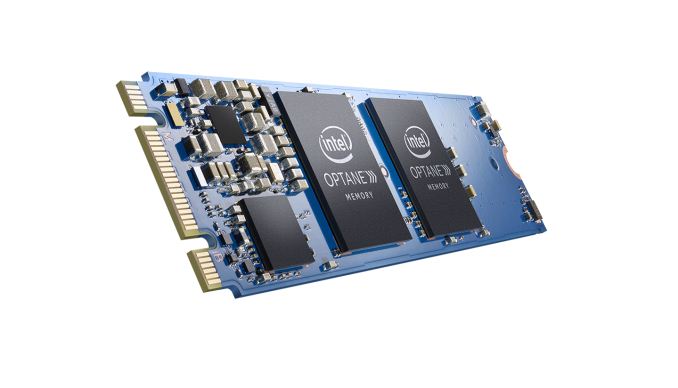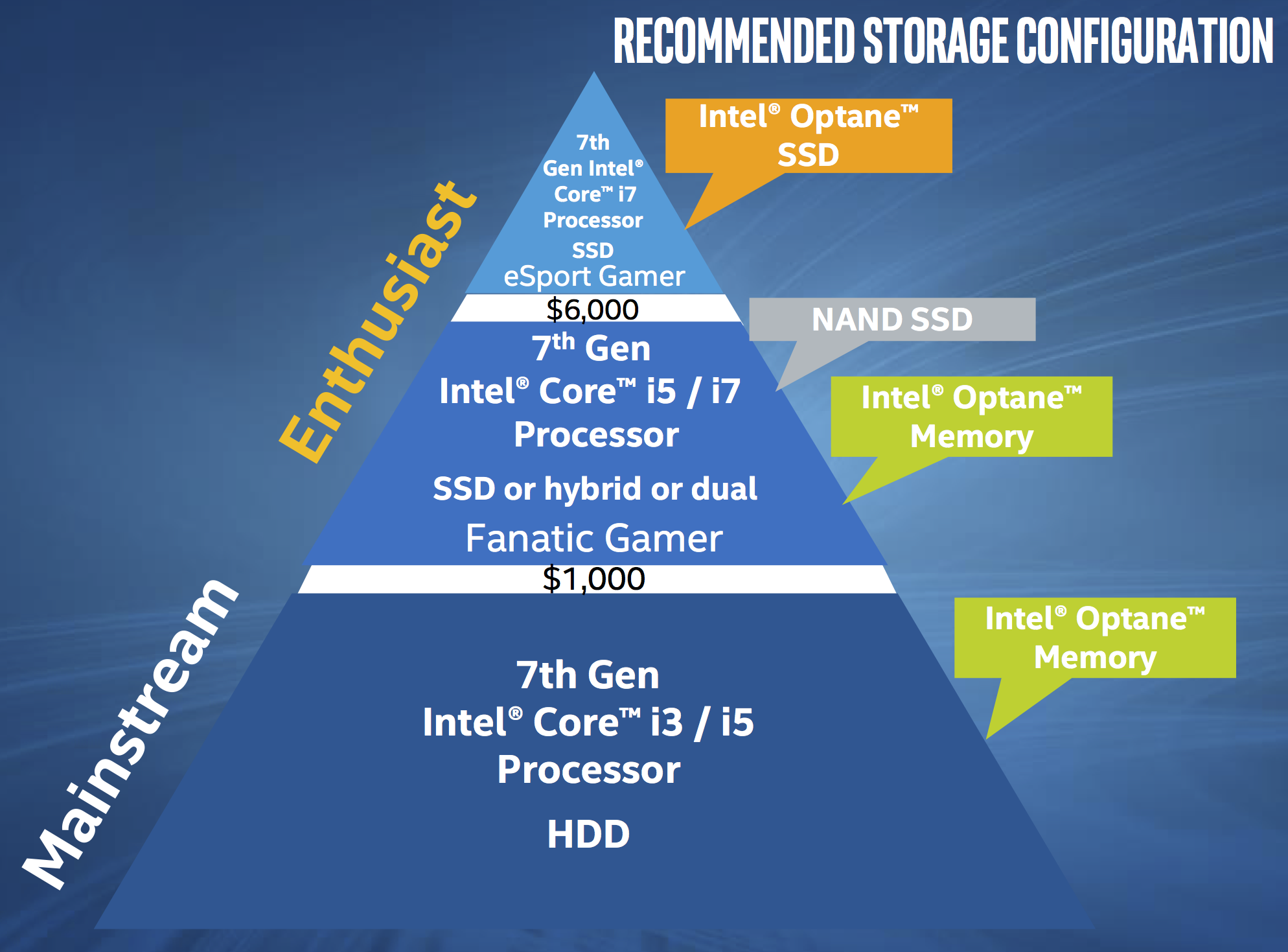Intel Launches Optane Memory M.2 Cache SSDs For Consumer Market
by Billy Tallis on March 27, 2017 12:00 PM EST- Posted in
- SSDs
- Storage
- Intel
- SSD Caching
- M.2
- NVMe
- 3D XPoint
- Optane
- Optane Memory

Last week, Intel officially launched their first Optane product, the SSD DC P4800X enterprise drive. This week, 3D XPoint memory comes to the client and consumer market in the form of the Intel Optane Memory product, a low-capacity M.2 NVMe SSD intended for use as a cache drive for systems using a mechanical hard drive for primary storage.
The Intel Optane Memory SSD uses one or two single-die packages of 3D XPoint non-volatile memory to provide capacities of 16GB or 32GB. The controller gets away with a much smaller package than most SSDs (especially PCIe SSD) since it only supports two PCIe 3.0 lanes and does not have an external DRAM interface. Because only two PCIe lanes are used by the drive, it is keyed to support M.2 type B and M slots. This keying is usually used for M.2 SATA SSDs while M.2 PCIe SSDs typically use only the M key position to support four PCIe lanes. The Optane Memory SSD will not function in a M.2 slot that provides only SATA connectivity. Contrary to some early leaks, the Optane Memory SSD uses the M.2 2280 card size instead of one of the shorter lengths. This makes for one of the least-crowded M.2 PCBs on the market even with all of the components on the top side.
The very low capacity of the Optane Memory drives limits their usability as traditional SSDs. Intel intends for the drive to be used with the caching capabilities of their Rapid Storage Technology drivers. Intel first introduced SSD caching with their Smart Response Technology in 2011. The basics of Optane Memory caching are mostly the same, but under the hood Intel has tweaked the caching algorithms to better suit 3D XPoint memory's performance and flexibility advantages over flash memory. Optane Memory caching is currently only supported on Windows 10 64-bit and only for the boot volume. Booting from a cached volume requires that the chipset's storage controller be in RAID mode rather than AHCI mode so that the cache drive will not be accessible as a standard NVMe drive and is instead remapped to only be accessible to Intel's drivers through the storage controller. This NVMe remapping feature was first added to the Skylake-generation 100-series chipsets, but boot firmware support will only be found on Kaby Lake-generation 200-series motherboards and Intel's drivers are expected to only permit Optane Memory caching with Kaby Lake processors.
| Intel Optane Memory Specifications | |||
| Capacity | 16 GB | 32 GB | |
| Form Factor | M.2 2280 single-sided | ||
| Interface | PCIe 3.0 x2 NVMe | ||
| Controller | Intel unnamed | ||
| Memory | 128Gb 20nm Intel 3D XPoint | ||
| Typical Read Latency | 6 µs | ||
| Typical Write Latency | 16 µs | ||
| Random Read (4 KB, QD4) | 300k | ||
| Random Write (4 KB, QD4) | 70k | ||
| Sequential Read (QD4) | 1200 MB/s | ||
| Sequential Write (QD4) | 280 MB/s | ||
| Endurance | 100 GB/day | ||
| Power Consumption | 3.5 W (active), 0.9-1.2 W (idle) | ||
| MSRP | $44 | $77 | |
| Release Date | April 24 | ||
Intel has published some specifications for the Optane Memory drive's performance on its own. The performance specifications are the same for both capacities, suggesting that the controller has only a single channel interface to the 3D XPoint memory. The read performance is extremely good given the limitation of only one or two memory devices for the controller to work with, but the write throughput is quite limited. Read and write latency are very good thanks to the inherent performance advantage of 3D XPoint memory over flash. Endurance is rated at just 100GB of writes per day, for both 16GB and 32GB models. While this does correspond to 3-6 DWPD and is far higher than consumer-grade flash based SSDs, 3D XPoint memory was supposed to have vastly higher write endurance than flash and neither of the Optane products announced so far is specified for game-changing endurance. Power consumption is rated at 3.5W during active use, so heat shouldn't be a problem, but the idle power of 0.9-1.2W is a bit high for laptop use, especially given that there will also be a hard drive drawing power.
Intel's vision is for Optane Memory-equipped systems to offer a compelling performance advantage over hard drive-only systems for a price well below an all-flash configuration of equal capacity. The 16GB Optane Memory drive will retail for $44 while the 32GB version will be $77. As flash memory has declined in price over the years, it has gotten much easier to purchase SSDs that are large enough for ordinary use: 256GB-class SSDs start at around the same price as the 32GB Optane Memory drive, and 512GB-class drives are about the same as the combination of a 2TB hard drive and the 32GB Optane Memory. The Optane Memory products are squeezing into a relatively small niche for limited budgets that require a lot of storage and want the benefit of solid state performance without paying the full price of a boot SSD. Intel notes that Optane Memory caching can be used in front of hybrid drives and SATA SSDs, but the performance benefit will be smaller and these configurations are not expected to be common or cost effective.
The Optane Memory SSDs are now available for pre-order and are scheduled to ship on April 24. Pre-built systems equipped with Optane Memory should be available around the same time. Enthusiasts with large budgets will want to wait until later this year for Optane SSDs with sufficient capacity to use as primary storage. True DIMM-based 3D XPoint memory products are on the roadmap for next year.
Source: Intel












127 Comments
View All Comments
cheshirster - Tuesday, March 28, 2017 - link
As far as I understand you need not only low queue depth, you need also small random reads for optane to shine.On a large read like loading a big file SSD will win.
Windows will hold DLLs and libraries in RAM, you'll only get boost for the first run.
ImSpartacus - Monday, March 27, 2017 - link
I think it's just for ssd caching, but I agree that I'm also confused as to the value proposition to enthusiasts.Shadowmaster625 - Monday, March 27, 2017 - link
In the real world, it wont work. In a world of <$100 256GB SSDs, this is useless. There are zero benchmarks that show cache drives offer the same performance as a true SSD boot drive. It is useless on a notebook because no one wants to power up two drives constantly. If the HDD could be powered down most of the time it would be one thing, but I seriously doubt this cache will be smart enough to enable that.MrSpadge - Monday, March 27, 2017 - link
Why would it not do that? Cache the writes (SRT can do that) and wait flushing them to disk.dullard - Monday, March 27, 2017 - link
This particular product is for the low-end consumer (enthusiast versions are later this year or early next year). So, if you already have a high-end computer this particular version probably doesn't have a real-world benefit for you.The benefit for most people is that for $44 you can make a sluggish low-end computer far snappier. It is a pretty tiny price to pay for a potentially useful benefit. For example PC World shows a test where GIMP took 14 seconds to load, they popped in a Optane module, and now it took 3 to 4 seconds. That is a noticeable and significant boost for a pretty small cost.
I'd like to see more tests with full reviews to see if that is a one-off review or the norm. But I'm actually interested in it so far. No, it won't revolutionize the computer. But it might make certain tasks feel far less frustrating.
asmian - Monday, March 27, 2017 - link
Caching isn't the same as mind-reading what work you want to do next. You still have to have loaded GIMP at least once beforehand to benefit from it still being stored in your fast cache, and that first time will always take as long as it takes from your slow storage.I guess people who are RAM-starved and need to constantly open and close the same smallish programs from slow spinning drives they can't upgrade may feel a win, but the limitations on legacy processor/chipset support for this tech mean that users who would actually be able to fit it in their brand new motherboard (and be aware enough of it to do so) will doubtless already have an SSD for OS/program storage that negates virtually all the benefit, so they don't need it.
I vote Meh.
dullard - Monday, March 27, 2017 - link
I personally open programs like Word, Excel, internet browsers, etc repeatedly before turning off the computer. So having them in cache will be quite helpful. You are assuming that SSDs aren't sped up too. This particular version probably won't help the fastest SSDs, but it will help some of them (those of us who move their existing SSD to their new computer build for example). Finally, you got it on the RAM-starved point. Optane is a much better value proposition as $44 for 16 GB of more memory (albiet slower than normal memory) than as $44 for 16 GB of hard drive space.XZerg - Monday, March 27, 2017 - link
the only problem with your " benefit for most people is that for $44 you can make a sluggish low-end computer far snappier" is you didn't read the full article and realize the limitations, namely hardware requirements - must be a 7th gen system, and needs a m.2 slot. so why would anyone in their right mind get this over a typical m.2 ssd that will work with any system, not just 7th gen and above? also why would one get this when for the price of a 32gb of this i can get a 256GB sata ssd (bigger and faster writes), and meet most users storage requirements too as a full fledged drive?dullard - Tuesday, March 28, 2017 - link
Because it makes SSDs faster too.Lolimaster - Monday, March 27, 2017 - link
Between spending $44 for a band aid and $60-90 for a proper drive, the cheap option is a really bad investment.